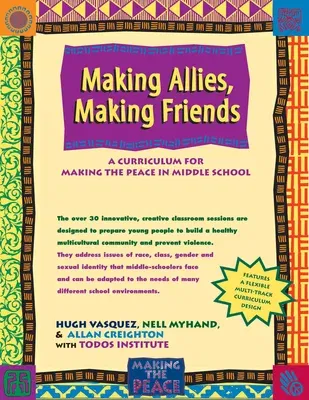Teaching Middle-School Youth to Respect Diversity and Make the Peace
The problem of violence seems ever more present throughout the world,
and the ability of people to make and support the peace is increasingly
challenged. Middle-school youth, the future leaders of our nation, are
at a critical age for developing the values, understanding and
community-building abilities that will enable them to work for social
justice and increase the peace in the years to come.
That is the goal of this curriculum: to inform young people about
becoming peaceful
citizens of a multicultural world. It also teaches them how to defend
themselves against violence and prepares them to develop positive
connections--alliances--with each other.
Part of the Making the Peace initiative, providing comprehensive
violence prevention resources for young people
Making Allies, Making Friends integrates with the Oakland Men's
Project's Making the Peace curriculum guide and related school and
youth-group materials, including Days of Respect, Helping Teens Stop
Violence, and I Can Make My World a Safer Place. The curriculum is
designed with multiple tracks and has 10 foundation sessions, 23
elective sessions in four groups, and 3 closing sessions. It can be used
in the classroom or by after-class, whole-school groups.
The curriculum teaches students:
- who they are, where they come from and what it means
- to build respect across all cultures
- about the roots of violence and their basis in race, gender,
- class and other forms of separation among people
- how to critically analyze what they are taught as accepted history
- the influence of the media in creating stereotypes and perpetuating
violence
- how our society provides benefits to some while excluding others
- what every young person can do to take action in their school or
community to bring peace and build alliances across all divisions
Making Allies, Making Friends starts with helpful hints for the
teacher or leader and detailed guidelines for delivering the course.
Each session includes an introductory game or warm-up, a theme
statement, background information, and an experience or activity.
Activities include journal writing, individual and group reflection,
critical thinking exercises, role-plays, posters,
story-telling/poetry/rap, and research projects. Reproducible handouts
and On Your Own exercises are provided to inspire deeper thought and
private reflection.

